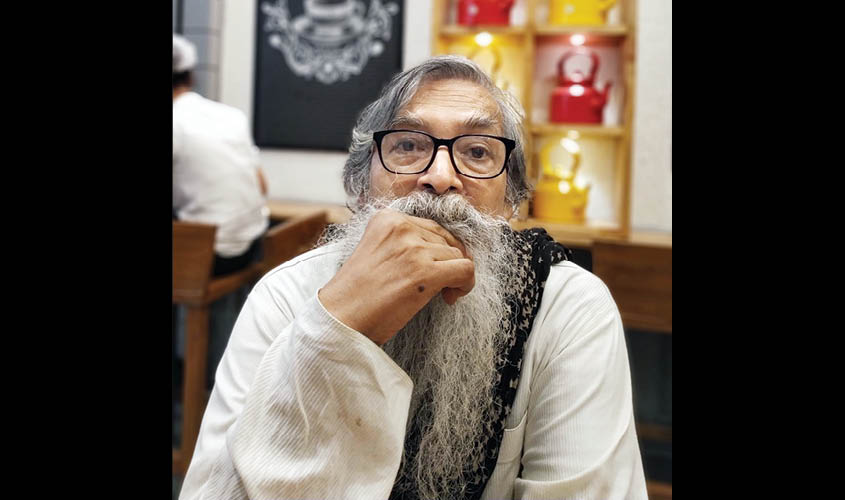Madhubani painter Santosh Kumar Das has many admirers in the West, but he has never had a solo show in his own country. Rerouted Realities, on view at Delhi’s Ojas Art Gallery, is the first such show that makes Das’ work its only focus, writes Bhumika Popli.
I was a bit cautious about one of my questions to the Madhubani painter Santosh Kumar Das. He has gained international acclaim, been the founder-director of Mithila Art Institute, and developed a new language of Madhubani painting by refusing to take the conventional path. But he has never had a solo show in his life before Rerouted Realities, which is now on view at Delhi’s Ojas Art Gallery.
So, with a little hesitation in my voice, I ask him, “Are you angry that you are getting this recognition so late in life?” He says, “It takes me nearly a year to finish one series. After spending so much energy on your art, you are completely numb, you are completely empty. You don’t think much about its future. But I definitely feel that if the works sell and are appreciated, I would have the money which would help me paint much better. These thoughts definitely come to my mind, but they don’t stay for long, because I always feel that an artist can create stunning paintings but an artist cannot decide the fate of his art.”
In his opinion, an artist’s job is to do his work honestly. The job of bringing that work to public attention can be left to gallery owners and curators. Kathryn Myers, an American painter and art curator, whose engagement with Indian art goes back at least 20 years, has put together Rerouted Realities.
Myers first saw Das’ work in 2005, at a group show in New York where his Gujarat series—comprising 23 paintings—was on display. This series was occasioned by the Gujarat riots of 2002, which affected the artist deeply. “I happened to be in Ahmedabad the day Gujarat riots started,” Myers says. “I was to give a lecture. A young man came up to me and said ‘Madam your lecture is cancelled, the city is burning and everyone is leaving.’ When in 2005, at the New York exhibition called Edge of Desire, I saw Das’ work, I remember being blown away. I was drawn to his style of work.”
According to her, Das has rightly identified the line as an essential element of Madhubani. Das breaks all stylistic conventions, but doesn’t ignore the traditional essence of this art form. She says, “For instance, the densely marked page typical of much Mithila art—Santosh also makes ample use of deliberately positioned voids, white, black or a luscious colour.”

A considerable part of Rerouted Realities comprises Das’ Krishna series. In these paintings, Krishna is represented in the Madhubani form. Das has made vivid use of colours here—there are plenty of yellows, blues, greens and, Das’ key strength, blacks.
Das has long been fascinated by the black colour. A few years ago, his work also featured in a book entitled Black: An Artist’s Tribute. He informs that Madhubani art in the ’70s made prominent use of the black pigment made by dried leaves and lamp soot. “Black is one colour which is always steady, unlike other colours which blend with each other. I like the characteristics of black—firm, rooted and steady. I encountered this steadiness in the lines of my mentor and inspiration, Ganga Devi, who was an acclaimed Madhubhani painter.”
One of Das’ students, Katie Lazarowicz, regards black as the most “vibrant colour” in Das’ oeuvre.
Das has a good rapport with his students and was the first teacher at the Mithila Art Institute in Madhubani. He believes in making students understand the difference between design and art, and he wants the world to recognise the artistic language of Madhubani. He considers his service to the Madhubani form as his major achievement as an artist.
He says, “I teach my students with proper methodology, including a proper sense of technique, so that they can learn Madhubani as an art and not just as a ritualistic practice which has been there in the past. This limits your creativity and as an artist one needs to take up challenges and push boundaries.”
Having a degree in English literature, the artist once wanted to become a professor, but dropped the idea on the advice of his American friends. “They told me, you can show the world what you have through your art. Why do you want to give that up for literature?” he says.
But his passion for stories never left him. He found himself deeply inspired by the folk and mythological tales that he heard as a child. He also credits his visualising power to the movies he saw. “I feel this visual medium gave me an ability to think freely and enhanced my imagination. I find that in real life you cannot always retain the composure, the pauses and the fluidity of thought that art requires. So you cannot be an artist if you’re always in the real world. Whenever I create a series, I am in some new fantasy place altogether.”
The show is on view at Delhi’s Ojas Art Gallery till 10 February

